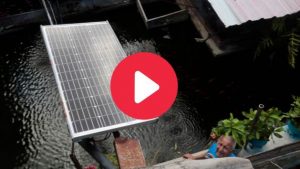Cuban Innovator Drives Sustainable Energy Solutions – VIDEO
 12 Januari 2023
12 Januari 2023

By Luis Brizuela and Jorge Luis Baños
HAVANA, Jan 11 2023 (IPS)
Félix Morffi supports the energy needs of his home with the help of the sun, in some cases through handcrafted solutions that make the most of an alternative source that is abundant in Cuba, but still used very little.
With two tanks, glass, aluminum sheets, as well as cinderblocks, sand and cement, the 86-year-old retiree created, in 2006, a solar heater that meets his household needs.
“You build it today and tomorrow you have hot water; anyone can do it, and if they have a bit of advice, all the better,” said the retired mid-level machine and tool repair technician who lives in the municipality of Regla, one of the 15 that make up Havana.
He also designed and made a dryer that uses the heat of the sun to dehydrate fruits, spices and tubers, which he assembled mostly with recycled products such as pieces of wood, nylon, acrylic and aluminum sheets.
On the roof of his house, 16 solar panels imported in 2019 provide five kilowatts of power (kWp) and help run his small automotive repair shop where he works on vehicles for state-owned companies and private individuals, an independent enterprise that he set up next to his house.
The innovator believes that despite the economic conditions, with a little ingenuity people can take advantage of the natural elements, because “the sun shines for everyone; the wind is there and costs you nothing, but your wealth is in your brain”
In addition to covering his household needs, he provides the surplus electricity to the national grid, the National Electric Power System (SEN).
Morffi said more training is needed among personnel involved in several processes, and he cited delays of more than a year between the signing of the contract with Unión Eléctrica and the beginning of payments for the energy surpluses provided to the SEN, as well as “inconsistency with respect to the assembly” of the equipment.
Although Cuba has a national policy on renewable energy sources, “there is still a lot of ignorance and very little desire to do things, and do them well. Awareness-raising is needed,” he argued.
The innovator believes that despite the economic conditions, with a little ingenuity people can take advantage of the natural elements, because “the sun shines for everyone; the wind is there and costs you nothing, but your wealth is in your brain.”
In his backyard, a small solar panel keeps the water flowing from a well for his barnyard fowl and an artificial pond holding a variety of ornamental fish as well as tilapia for family consumption.
The construction of a small biodigester, about four cubic meters in size, is also at an advanced stage on his land, aimed at using methane gas from the decomposition of animal manure and crop waste, for cooking.
Morffi, who manages these activities with the backing of several family members, also plans to import three small wind turbines of 0.5 kWp each and a new batch of 4 kWp solar PV panels.
His vision is to turn his house into a space for the production and promotion of renewable energies in Cuba.
To this end, he has the support of the non-governmental Cuban Society for the Promotion of Renewable Energy Sources and Respect for the Environment (Cubasolar), of which Morffi has been a member since 2004.
Since 2014, Cuba has had a Policy for the Development of Renewable Energy Sources and their Efficient Use. And in 2019, Decree Law 345 established regulations to increase the share of renewables in electricity generation and steadily decrease the proportion represented by fossil fuels.
According to studies, this archipelago of more than 110,800 square kilometers with an annual average of 330 sunny days receives an average solar radiation of more than five kilowatts per square meter per day, considered to be a high level that provides enormous potential in terms of energy.
The solar energy program appears to be the most advanced and with the best opportunities for growth. Over the last decade, several solar parks have been built, providing more than 75 percent of the renewable energy produced locally.
But clean sources account for just five percent of the island’s electricity generation, an outlook that the authorities want to radically transform, setting an ambitious goal of 37 percent by 2030.
